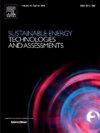The role of changing runner geometry in expanding energy efficiency of a centrifugal pump as turbine (PAT)
IF 7.1
2区 工程技术
Q1 ENERGY & FUELS
Sustainable Energy Technologies and Assessments
Pub Date : 2025-05-01
DOI:10.1016/j.seta.2025.104329
引用次数: 0
Abstract
Escalating global energy demand and environmental challenges have created a paradigm shift toward expanding the capacity of renewable energy power plants. The utilization of centrifugal PATs is an economically viable approach for producing clean energy in pressure reduction stations. This study evaluates PAT performance with experimental and numerical approaches. It verifies the validity of numerical solutions by comparing them with the experimental results. Analysis of the PAT performance shows that the absence of a control mechanism to guide the inlet fluid into the runner results in separation and vortex formation within the passages, and the efficiency significantly decreases. A new runner is designed by modifying three blade parameters, including thickness, leading edge, and curvature, to improve hydropower performance within its operating range. Investigating flow fields shows that a special runner reduces adverse flow phenomena, such as blade inlet shock, flow separation, and vortex formation within the flow passage. As a result of reduced losses and improved efficiency, PAT performance increases across the whole working range. The results indicate that the efficiency of PAT with a special runner at low-load condition (0.8Qd), design condition (1.0Qd), high-load condition (1.2Qd), and over-load condition (1.3Qd) is raised by 2.58%, 3.04%, 7.23%, and 4.53%, respectively.
改变流道几何形状对提高离心泵水轮机能效的作用
不断升级的全球能源需求和环境挑战导致了一种范式转变,即扩大可再生能源发电厂的产能。利用离心式pat是一种在经济上可行的减压站生产清洁能源的方法。本研究通过实验和数值方法评估PAT的性能。通过与实验结果的比较,验证了数值解的有效性。对PAT性能的分析表明,由于缺乏引导进口流体进入流道的控制机构,导致通道内分离和涡流形成,效率显著降低。通过改变叶片厚度、前缘、曲率等三个参数,设计了一种新型转轮,提高了转轮在工作范围内的水力性能。对流场的研究表明,特殊的流道减少了不利的流动现象,如叶片进口激波、流动分离和流道内涡的形成。由于减少了损耗和提高了效率,PAT的性能在整个工作范围内都得到了提高。结果表明,在低负荷工况(0.8Qd)、设计工况(1.0Qd)、高负荷工况(1.2Qd)和过载工况(1.3Qd)下,采用特殊转轮的PAT效率分别提高了2.58%、3.04%、7.23%和4.53%。
本文章由计算机程序翻译,如有差异,请以英文原文为准。
求助全文
约1分钟内获得全文
求助全文
来源期刊

Sustainable Energy Technologies and Assessments
Energy-Renewable Energy, Sustainability and the Environment
CiteScore
12.70
自引率
12.50%
发文量
1091
期刊介绍:
Encouraging a transition to a sustainable energy future is imperative for our world. Technologies that enable this shift in various sectors like transportation, heating, and power systems are of utmost importance. Sustainable Energy Technologies and Assessments welcomes papers focusing on a range of aspects and levels of technological advancements in energy generation and utilization. The aim is to reduce the negative environmental impact associated with energy production and consumption, spanning from laboratory experiments to real-world applications in the commercial sector.
 求助内容:
求助内容: 应助结果提醒方式:
应助结果提醒方式:


